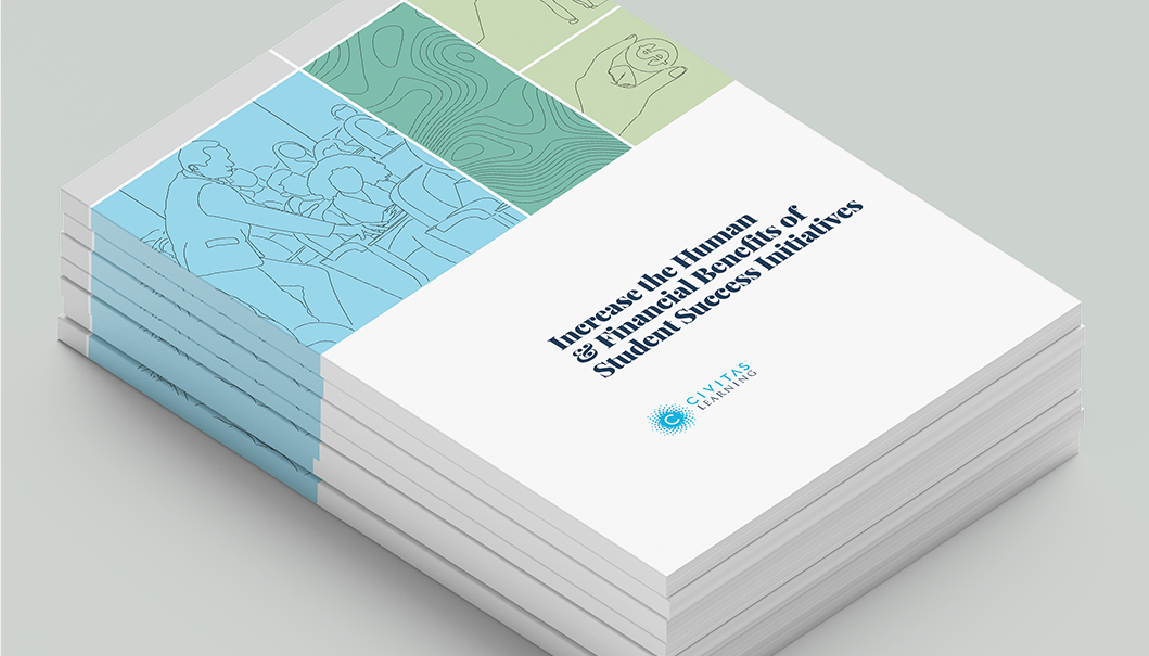We know that student success analytics (diagnostic, descriptive, prescriptive, and predictive) provide valuable insights for higher education. Student-level persistence and completion predictions can identify individuals at risk of stopping out. Insight into predictive factors, such as the average number of days enrolled before the start of the term, reveals opportunities to connect students to the most beneficial interventions.
The ability to promptly address specific student needs with effective support makes it feasible for educators to provide proactive support needed to improve outcomes at scale continually. On the other hand, the underuse or misapplication of analytics can cause uncertainty for faculty, advisors, and staff and diminish student outcomes.
To reap the benefits of student success analytics, higher education institutions need to empower student success leaders and frontline staff with the skills needed to understand and apply analytics in their daily work.
The successful implementation of student success analytics systems depends on professionals’ ability to adopt and use them widely. Simply flipping the switch to “on” won’t cut it.
Empower Frontline Staff to Understand the Role of Student Success Analytics
For analytics to be effectively used, it’s not enough to train your team to use a platform to access the information. You must also ensure they have the knowledge and training to understand how best to take action on the insights surfaced by these technologies. These insights provide strategic input to higher ed professionals as they determine where to place their professional experience in helping their students and provide context to tailor their support to drive desired outcomes effectively.
To harness the full benefits of student success analytics, your institution must invest in the professional development of all student success analytics users. This helps dispel uncertainty and empowers staff members to acquire and maintain a clear understanding of how best to use different types of analytics collectively.
Common Mistakes to Avoid in Technology Change Management
4 Principles to Avoid the Misuse of Student Success Analytics
To build a more robust understanding of analytics across your institution, begin by educating your team on the true nature of analytics. When it comes to effectively using student success platforms that include analytics, training extends beyond the “click here, click there” we’re accustomed to when working with other software.
Here are a few fundamental principles all student success professionals should understand about how student success analytics work:
1. Predictive models have strengths and limitations
2. Student success analytics augment the decision-making of intelligent users
3. Predictions are tentative insights that inform the design of supportive interventions
4. Interventions Should Do No Harm
1. Predictive Models Have Strengths and Limitations
Studies in neuroscience have revealed that the human brain has a deep bias towards certainty and even experiences a deep threat response to any sense of ambiguity. This makes it difficult for many to understand predictive models’ value and limitations.
The value of predictions is that they can change. Because they are dynamic, predictions based on factors like engagement, enrollment, behavior, and academic progress create an opportunity for higher ed professionals to influence a student’s trajectory. Although a margin of error exists, predictive student success analytics based on various static and dynamic data sources rather than demographic data alone provides an opportunity to intervene and change course.
Consequently, some mistakenly treat tentative predictions as representing certain conclusions or taking an all-or-nothing stance in their thinking, believing that only models with 100% accuracy are worth professional investment.
To avoid misunderstandings and to make the most of analytics, it’s essential to socialize such limiting realities amongst users. Predictions are projections, not certainties. Instead, they should be used to inform timely no-harm interventions and high-quality outreach. Developing internal mental frameworks that allow for a proper understanding of predictive analytics is crucial for the ethical and effective use of these tools in higher education.
2. Student Success Analytics Enhance the Decision-Making of Intelligent Users
Student success analytics can be used to identify opportunities for targeted outreach. Still, professionals should ultimately design the intervention’s nature and content. Research has shown that heavy reliance on predictive modeling can improve decision-making accuracy but reduce one’s likelihood of accessing professional knowledge and experience, acting as a cognitive “crutch.” To avoid this, it is important to remember that predictive analytics should enhance, not replace, human ingenuity.
When users don’t understand that analytics are meant to enhance their expertise, it can lead to a lack of personal initiative or creativity. This can ultimately lead to diminished engagement or professional fulfillment.
To avoid these risks, it’s important to balance the intelligence provided by analytics systems and the ingenuity and expertise of human professionals. Instead of relying solely on the predictions provided by the analytics system, professionals should use these insights as input for their decision-making and creative problem-solving. Institutions can use analytics effectively and ethically by striking the right balance.
How AI-Based Predictive Modeling Enhances Student Support
3. Predictions Inform the Design of Supportive Interventions
When using predictive analytics to identify students at risk of leaving the institution, it’s important to approach the situation carefully. Because the predictions provided by these models are tentative and uncertain, it’s crucial not to send inappropriate signals of concern to students. This can be especially damaging for students who are already vulnerable and can lead to a negative self-fulfilling prophecy.
Instead of relying solely on the analytics system, professionals should use these insights as context for engaging in authentic, compassion-focused human interaction with students. This will allow them to better understand the students’ lived experiences and help identify the root causes of academic distress. By using predictions to signal the need for supportive intervention, professionals can avoid sending inappropriate messages of concern and instead focus on building human connections to help students succeed.
Furthermore, it’s important to remember that the insights provided by predictive analytics are not final conclusions but rather just the beginning of a long intervention process. Rather than viewing the predictions as definitive answers, professionals should use them as a trigger for further exploration and inquiry. Professionals can continue seeking solutions and refining their interventions by adopting an iterative approach.
4. Interventions Should Do No Harm
Student success analytics, while useful, must be used with caution to prevent undue harm to the students who are the subject of the predictions. For example, using predictions to exclude students from certain experiences and benefits, such as admission to an academic program, is an example of a very harmful course of action. Using predictions to exclude can hinder students who could succeed in higher education. Predictions carry a margin of error, which means precluding large sets of students with low odds of success ultimately leads to precluding students who were actually on the path to success all along.
Instead, an appropriate approach to using student success analytics is to provide preventative measures and supportive interventions, such as resources like enhanced advisor attention, faculty mentoring, and study skills development. This “take your academic vitamins” approach ensures that all messaging from predictive models remains positive and is designed to support deepened commitment. Additionally, when predictive models accurately identify students in distress, no-harm interventions should be implemented to maintain students’ dignity and sense of worth, which means avoiding revealing to them that predictive models are the source of the support being offered.
Overall, end users need to understand and prioritize no-harm interventions. When used with care and caution, student success analytics can identify students who may be struggling and enable professionals to provide timely support. By using predictive analytics in a preventative manner, we can help students overcome academic challenges and ultimately persist toward their goal of graduation. Furthermore, a commitment to no-harm interventions helps maintain students’ dignity and worth and allows us to support those who may have a low chance of success but have the potential to “beat the odds.”
Effective Use of Student Success Analytics Relies on the Preparedness of Its Users
These guiding principles provide a mental framework to reduce uncertainty, fatigue, and risk associated with using student success analytics. With the proper balance between systems of intelligence and professional intelligence, higher education institutions are better positioned to provide students with the support they need to succeed.
In the end, the successful implementation of student success analytics systems depends on professionals’ ability to adopt and use them widely. Simply flipping the switch to “on” won’t cut it. To be successful, institutions must identify and internalize the appropriate role of analytics in their work to support the high-quality, ethical use of analytics on behalf of their students.
Increase the Impact of Your Student Success Initiatives
Lafond, D., DuCharme, M. B., Gagnon, J. F., & Tremblay, S. (2012). Support requirements for cognitive readiness in complex operations. Journal of Cognitive Engineering and Decision Making, 6(4), 393-426.
Harris, R. (2018, February 22). Synergy between nurses and automation could be key to finding sepsis early. All Things Considered. National Public Radio.
Kane, G. C., Phillips, A. N., Copulsky, J. R., & Andrus, G. R. (2019). The Technology Fallacy: How People are the Real Key to
Digital Transformation. MIT Press.Lafond, D., DuCharme, M. B., Gagnon, J. F., & Tremblay, S. (2012). Support requirements for cognitive readiness in complex operations. Journal of Cognitive Engineering and Decision Making, 6(4), 393-426.






